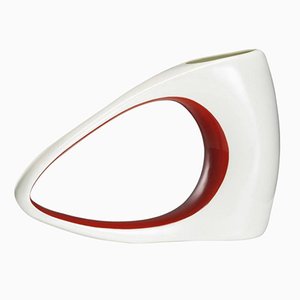How Swiss-American designer Philippe Cramer cultivated his enduring place in the landscape of luxury design
Rock Steady
Philippe Cramer’s design aesthetic is clean and immaculately produced; aimed at heirloom quality rather than flash-in-the-pan trendiness. Nothing feels hurried in his work. Even his experiments with new mediums and forms are always moderated by the maturity of his design expression. “I do not particularly try to be relevant to the current times,” Cramer says. “I work with my instincts, staying as close to my emotions and inner self as possible.” This may sound casual, but it represents a commitment to creative autonomy that the designer carefully safeguards. And it’s paid off. In an industry that celebrates the latest shooting star with a fervor that tends to outshine the steady flame of the quietly established achievers, this Swiss-American talent has sustained an enduring place in the landscape of luxury design.
Born in New York in 1970, Cramer was raised in Geneva, the city to which he eventually returned after graduating from Parson’s School of Design in New York with a Bachelor of Fine Arts in the late 1990s. He founded his design studio Cramer & Cramer in 2001, which he expanded in 2003 to include a separate gallery space in the arts district of Geneva, the Quartier des Bains. As Creative Director of the company, Cramer designs collections of furniture, porcelain, silverware, and jewelry both under his eponymous label and in collaboration with high-end clients like Dom Pérignon, Georg Jensen, and Bernhardt Design, which launched the Philippe Cramer Collection—the designer’s first furniture line for the U.S. market—in 2005.
Rather in contrast to the highly refined, perfectly finished character of his work, Cramer himself turns out to be a fierce nonconformist. He eschews the large commercial design fairs that can blanket over nuance while highlighting easy-to-digest fads; he claims not to have visited Salone del Mobile, for example, for quite some time. “Independence of thought is difficult when we are bombarded with beautiful images of products perfectly styled in a set up interior,” he explains. He puts little stock in trends, because the hype exerts too strong an influence, causing one to “lose touch with our instincts.”
Indeed, Cramer’s approach often has more in common with the visual arts than product design. His ideas begin as doodles, which he eventually develops into sketches for new pieces that are generally produced for the collector market and endowed with a charged visual impact. “I let my hand be the guide,” Cramer explains. In 2010, the Geneva Museum of Art & History offered him a unique opportunity to create something for the Salon de Cartigny, the prestigious museum’s opulently appointed room dedicated to the applied arts of the 18th and 19th centuries. The result was L’Ornament Jamais, an exhibition of Cramer’s bespoke collection of whitewashed wooden furniture with gold accents that reinterpreted archetypal designs of the period in a strikingly light and contemporary manner. These works have since become part of the museum’s permanent collection.
The highly personal aspect of Cramer’s practice leads him toward poetic propositions that seem imbued with a flash of the designer’s own essence; his roots. In Golden Landscapes (2012), a series one-of-a-kind, handcrafted tapestry, for instance, you’ll find clear echoes of his Swiss homeland rendered in lovingly luminous detail. Similarly, the whitened ash and gold leaf palette of the Rorschach Cabinet (2012) glows like the reflection of lemony winter sunlight off a snowy mountain peak. For Cramer, the use of reflective surfaces—the way his pieces dance with refracted light — is a conscious methodology “to assist me in creating my vision of a positive and joyful environment.” He thinks of his work as “antidote design,” which, he hopes, can go some way towards alleviating the everyday stresses of contemporary life for the users.
While Cramer has forged a path all his own, always a step outside the mainstream, he has secured a steady stream of commissions from design brands with the most venerable legacies. Cramer shares that he has recently embarked on a new collaboration with the Hermès Group, designing for the company’s Petit H label; an experimental division under the guidance of Pascale Mussard that commissions independent designers to upcycle discarded materials. Contributing home accessories, furniture, and jewelry to the collection, Cramer describes the project as combining design and craft while using “spectacular materials otherwise destined for the trash.” “It’s mind blowing,” he enthuses, adding, “I wish all luxury companies would do the same.” Cramer is also currently in the midst of preparing an ARTGenève exhibition, where he will show his latest work for the first time in an art context. Cramer hopes that “all fine art fairs will soon incorporate design as an integral part of their program, to prove that creation is one and does not need to be segmented.” We’ll certainly be watching to see where the steady glow of this design stalwart’s inspiration leads next.
-
Text by
-
Gretta Louw
A South-African born Australian currently based in Germany, Gretta is a globetrotting multi-disciplinary artist and language lover. She holds a degree in Psychology, and has seriously avant garde leanings.
-


